Why Climate Change Will Crush Civilization Like a Bug
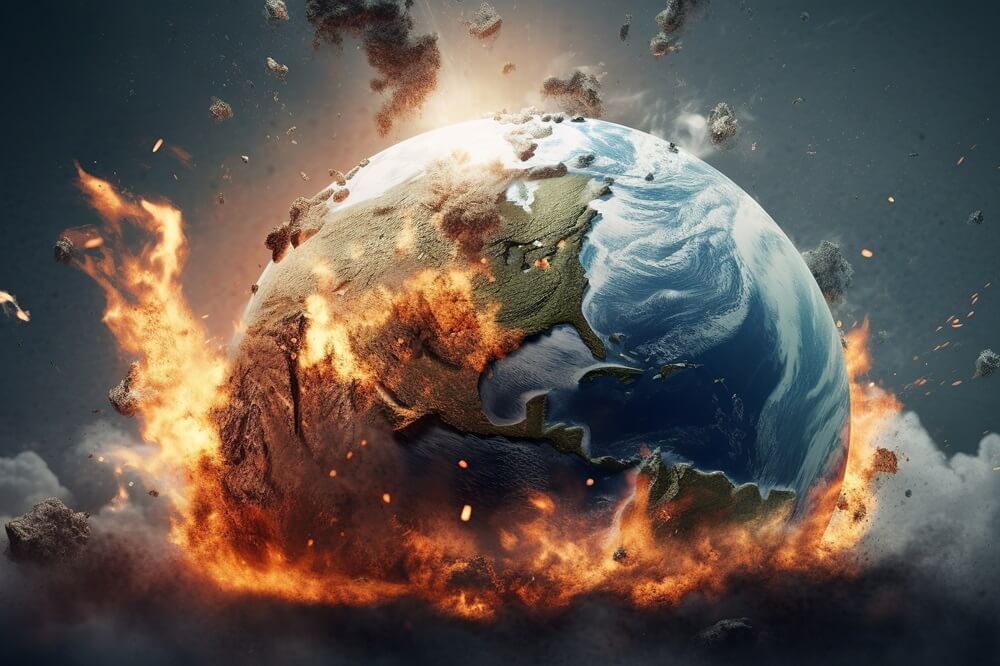
Despite record-breaking floods, droughts, heat waves, and wildfires this year, I’ve noticed a surge in climate denialism on the Internet. This baffles me. You'd think that as the impacts of climate change become more obvious, people would start waking up and demanding action. Instead, it seems people are burying their heads even deeper in the sand.
I expressed my frustration over this in a comment on Reddit, where I asked, “What is with all the climate deniers and minimizers in this sub lately?” One person responded, “It's called not believing the government approved narratives.”
I literally laughed out loud when I read that. The person who left the comment has absolutely no idea what’s going on in the world. As I said to him, “The government approved narrative is that we can still stop climate change by switching to green energy. The reality is that it's too late to stop climate breakdown, and the government is only making it worse.”
Climate deniers seem to have this idea that governments and climate activists are on the same side. The truth is that governments are mostly ignoring climate change while sowing apathy by telling people we’ll be “net zero by 2050.”
We’re not going to make it to 2050. And in this article, I’m going to explain why.
Before I continue, I need to mention a few things. First, although most of my readers are already familiar with the basics of climate change, I’m going to cover them again so that anyone can read this article and understand it.
Second, if you accept the science of climate change but still believe we can save modern civilization, this article could be very upsetting. In fact, it will be downright scary, but it’s important to face reality so we can make better decisions moving forward.
And third, I want to repeat what I said in my last article: Climate activism is not a waste of time. The fewer fossil fuels we burn, the less we change the climate, the less damage we do to the biosphere, and the less suffering we cause. Whatever happens, attempting to save as much of the natural world as possible is still worthwhile.
Okay, let’s dive in…
Carbon Dioxide
Carbon dioxide is kind of like the thermostat for the planet. Increase the amount of CO2 in the atmosphere, and the average global temperature goes up. Decrease the amount of CO2 in the atmosphere, and the average global temperature goes down.
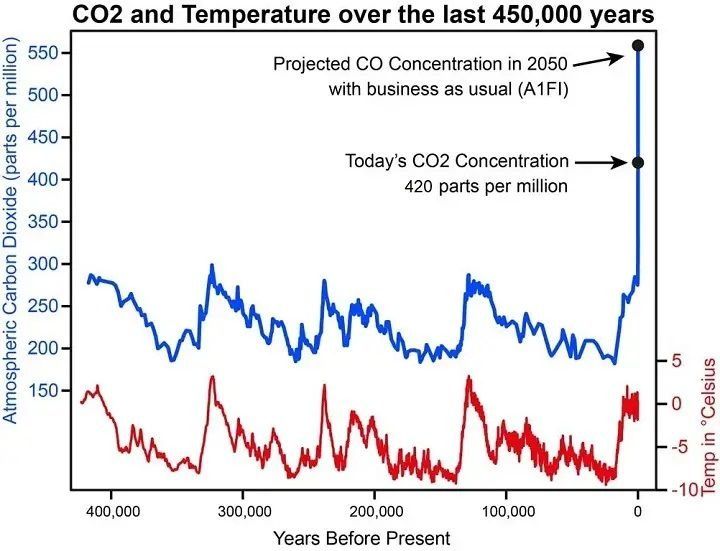
This happens because CO2 functions like a blanket, keeping some infrared radiation from escaping the planet and thus warming the surface. Without CO2, the planet would be about 32°C colder. This is basic physics.
Some people point out that there were times in the past when the temperature went up before CO2 went up, and that’s true. Solar cycles, along with Milankovitch cycles, occasionally increased temperatures.
But the higher temperatures caused more wildfires and more thawing of permafrost, releasing CO2 and other greenhouse gases, which caused temperatures to rise even more until a new equilibrium was reached.
The point is, CO2 and temperature always go up and down in lockstep. And given that humans have added about 1.6 trillion tons of CO2 to the atmosphere and temperatures are rising rapidly, it’s pretty obvious what’s going on.
I’m not going to attempt to prove that humans are causing climate change. This has already been proven again and again, and 99% of climate scientists agree. If you don’t want to believe them, then you’re rejecting an entire field of science, and there’s nothing I can do to convince you.
If you’re on the fence, check out this article about why I stopped being a climate skeptic and reluctantly admitted that climate change is real.
The Holocene
To understand why climate change is such a big problem, you need to know about a geological epoch known as the Holocene, which began nearly 12,000 years ago. Take a look at the graph below.
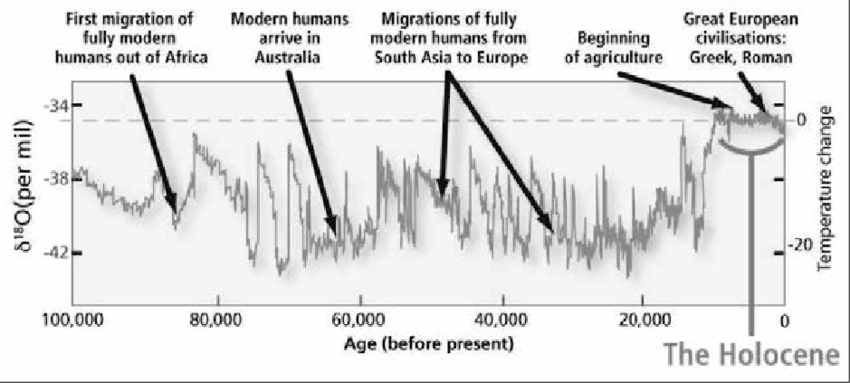
Notice that the average global temperature went up and down by several degrees on a regular basis until about 12,000 years ago, when temperatures became very stable, never varying by more than 1°C.
During this time, the Earth-energy system was well balanced, releasing as much energy as it took in. Because of that, weather patterns became very stable. The first and last freezes, the rainy seasons, and the heatwaves all happened around the same times every year.
Thanks to the weather becoming more predictable, people were able to start large-scale agriculture, and this led to the first civilizations. If not for the Holocene, humans would probably still be hunter-gatherers.
Imagine a spinning top. It seems like it will spin forever, but then you reach out and tap it with your finger. By doing this, you’ve added energy to the top, and now it begins to wobble.
Humans have done the same thing to planet Earth. By adding massive amounts of energy to the Earth-energy system, we’ve caused it to start wobbling—or flickering—bringing extreme temperature fluctuations and weather events all over the planet.
As a result, the Holocene is nearly over, and we’re about to officially enter a new geological epoch known as the Anthropocene.
The Jet Stream
A great example of how humans are changing the climate is the behavior of the jet stream. The jet stream is a narrow band of wind in the upper atmosphere that rapidly blows from west to east. There are actually several jet streams, but we’re going to focus on the Northern Hemisphere’s polar jet stream.
This particular jet stream acts as a barrier between the cold air in the Arctic and the warmer in the mid-latitudes. However, since the Arctic is warming 3.8 times faster than the rest of the globe, the difference in air temperature above and below the jet stream is declining, and that is causing the jet stream to meander much more than usual.
This is a big problem because it means the jet stream can now go really far North, bringing shockingly high temperatures to places that are usually cool (like what happened in the Pacific Northwest); or it can go really far South, bringing incredibly low temperatures to places that are usually warm (like what happened in Texas).
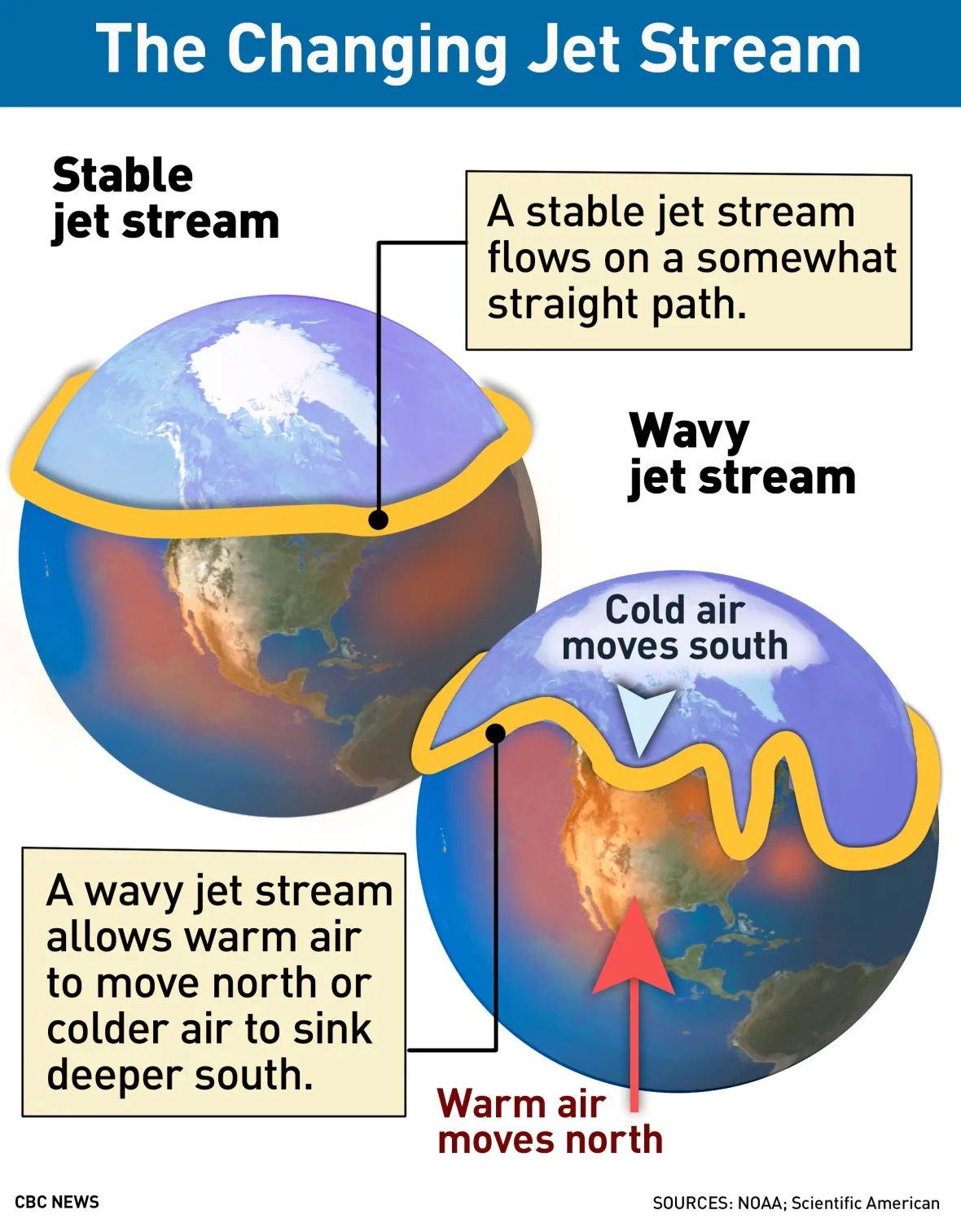
It can also cause a whiplash effect, where the same area can go from very hot to very cold, or very dry to very wet, in a matter of weeks or even days. This type of erratic weather makes farming difficult, and it’s going to get much worse. The jet stream is falling apart, and it’s starting to look like a Van Gogh painting.
Of course, a wavy jet stream isn’t the only threat to farms.
Floods
Over the past few years, we’ve seen some of the worst floods ever recorded. Hurricane Harvey, for example, dumped more rain than any storm in U.S. history. And in 2022, the U.S. had six 1,000-year floods in just one month.
These so-called 1000-year floods are now happening a lot more than once per 1000 years. They seem to be happening all the time. New England just had one recently, and there will be many more. Although climate scientists predicted more floods, they’re still shocked at how bad and frequent the floods have become.
The main reason for all these extreme floods is rising temperatures. For every 1°C increase in temperature, the air can hold 7% more moisture. With these floods happening at around 1°C of warming, just imagine what the weather will be like when we get to 2 degrees of warming—or 3.
Infrastructure was already getting more difficult to maintain thanks to dwindling amounts of energy and resources, and now floods are destroying roads, bridges, and other important structures at an accelerating pace. Not to mention people’s homes.
But floods don’t just destroy homes and infrastructure; they also destroy crops. Last year, Pakistan had one of its worst floods in history, covering 1/3 of the country with water and wiping out half the country’s breadbasket, which led to a major food crisis.
And this year, the global rice shortage is set to be the biggest in 20 years. This is the result of heavy flooding in China and India. There are already concerns about food shortages, and climate change is just getting started.
Droughts
The cruel irony of all these floods is that they usually happen in places that already get a lot of rain rather than places where the rain is really needed. In Somalia, residents are going through the worst drought in living memory—a drought that has caused widespread famine.
Countries like Somalia offer a preview of what’s coming to the rest of the world. Already, 1/4 of humanity is facing extreme water stress, and it’s going to get much worse. According to a new UN report, the global water crisis could easily spiral out of control in the coming years.
Just look at the Western United States. Despite a series of atmospheric rivers last winter, the Western U.S. is still going through the worst megadrought in 1200 years. As a result, the Colorado River keeps getting lower.
This is a serious problem as about 40 million people rely on the Colorado River for water, crops, and hydropower. Many scientists believe that within 20 years, the river will reach dead pool status, where the water levels are so low that they can’t flow downstream past the dams.
It’s hard to imagine what that would mean for states like Arizona and California, which are still growing rapidly. At the very least, farms would shut down, local economies would collapse, and millions of people would start migrating East, causing all sorts of chaos.
But other parts of the United States are in trouble, too. Farmers across the Midwest have been struggling with drought more and more every year. Recently, farmers in Michigan saw a 25-30% loss in yield due to a lack of rain. And in Kansas, farmers abandoned wheat fields after an extreme drought. The state ended up having its smallest wheat harvest in 60 years.
Droughts don’t just lead to small harvests, though. They also lower water levels in important rivers. In 2022, water levels in the Mississippi River got so low that thousands of barges filled with crops and other products got stuck in the middle of the river, causing a major traffic jam. It happened again this year, vexing the shipping industry.
The United States relies on the Mississippi river to transport goods and export them to the rest of the world. If it continues to get lower, it will have a terrible effect on the U.S. economy. As Mike Ellis, CEO of American Commercial Barge Line, said, “America is going to shut down if we shut down.”
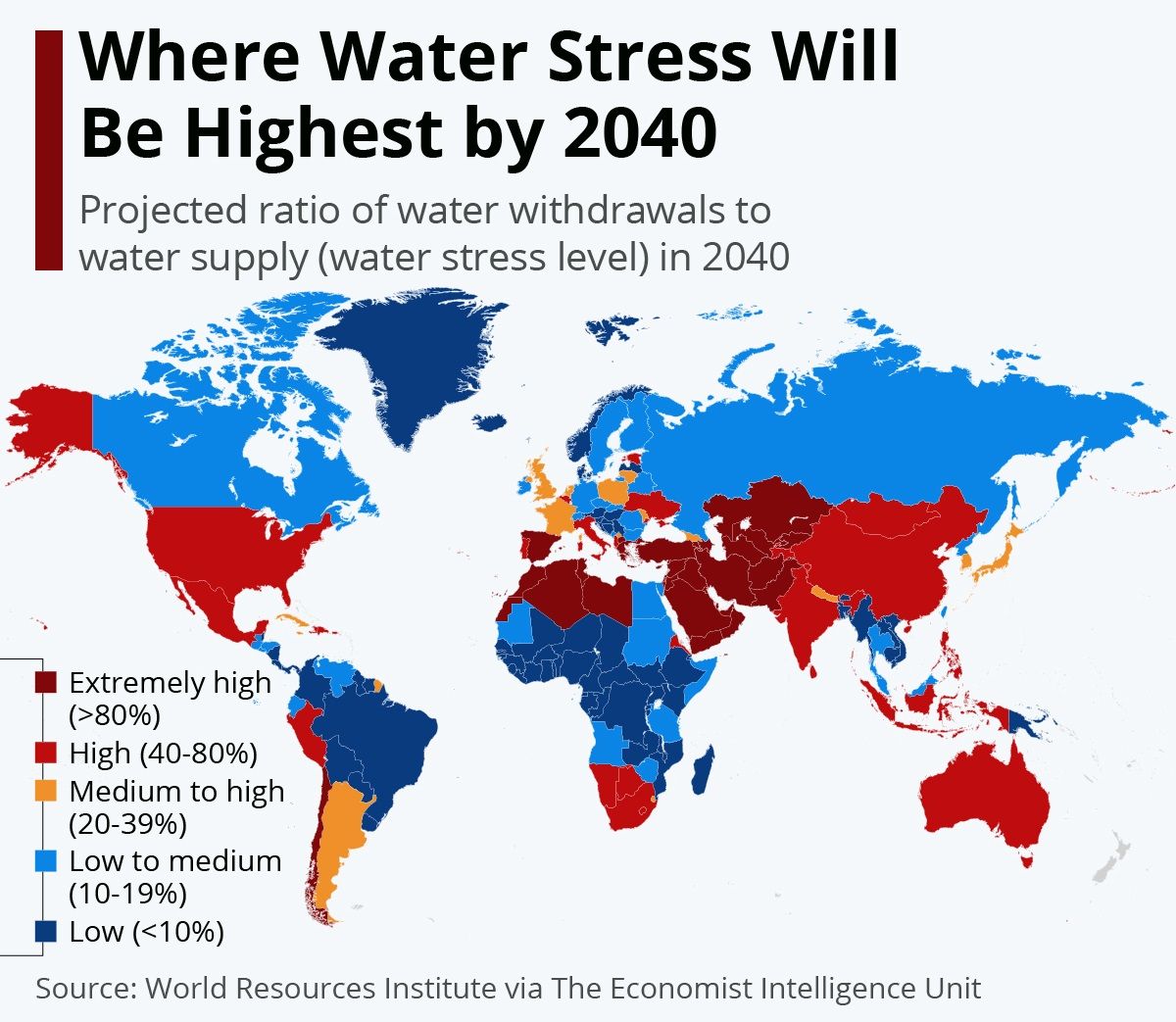
Obviously, drought is going to cause major problems for the United States. But incredibly, much of the world is even worse off. Europe is experiencing its worst drought in 500 years, and Spain and Portugal are the driest they’ve been in 1200 years.
Drought is also severely impacting countries like China, India, Iraq, Afghanistan, and dozens of other countries around the world. The lack of rain is going to cause economic problems, energy shortages, and food scarcity on a global scale as countries start hoarding whatever food they produce.
And remember, we don’t just need water for drinking and growing food. Water is used to make all sorts of things, from the vehicles we drive to the devices we use to the clothes we wear. With the global economy growing exponentially, combined with the fact that climate change is accelerating, the world could be virtually out of freshwater by 2040.
What About Aquifers?
In the United States, over 40% of water for drinking and irrigation comes from aquifers. Once the aquifers are gone, there will be catastrophic water and food shortages across the nation. Before you dismiss this as a problem for future generations, you should know that many of the most important aquifers, including the massive Ogallala aquifer, will be mostly gone in a matter of decades.
Every year, the water table gets lower and lower, sometimes dropping as much as 12 inches. And every year, more wells run dry, causing the value of farmland to plummet. Farms that were in families for generations will be abandoned as the Great Plains turns into a desert.
The same thing is happening all over the world in countries such as India, Iran, Peru, Saudi Arabia, and many others. This is going to have major geopolitical consequences. Water isn’t just essential for growing food—it’s essential for making everything from cars to clothing to construction materials.
As water shortages worsen, many countries will see it as an existential threat and may even go to war with neighboring countries. A great example is India and Pakistan, two nuclear-armed nations who hate each other but are forced to share the Indus river, which is slowly drying up.
The wise thing would be to stop pumping groundwater at an unsustainable rate, but as the climate crisis intensifies and droughts get even worse, most states and nations will drain aquifers even faster to stop crops from dying and keep taps from running dry. When crops are withering and people have nothing to drink, the loss of groundwater always becomes a problem for next year.
Some people argue that we should invest in desalination projects, and that is exactly what Saudi Arabia’s national water company is doing. While it’s true that this could help with water shortages, it would also require huge amounts of energy, not just to desalinate the water but to pump it hundreds miles to where it’s needed.
But as I already explained in my last article, energy is going to get a lot more expensive, so desalinated water and every product it’s used in will get more expensive, as well. There are no easy answers.
Heat
2023 is on track to be the planet’s hottest year on record. And it’s not just a little hotter than the previous hottest year. It’s way hotter. Take a look at 2023 compared to previous years:
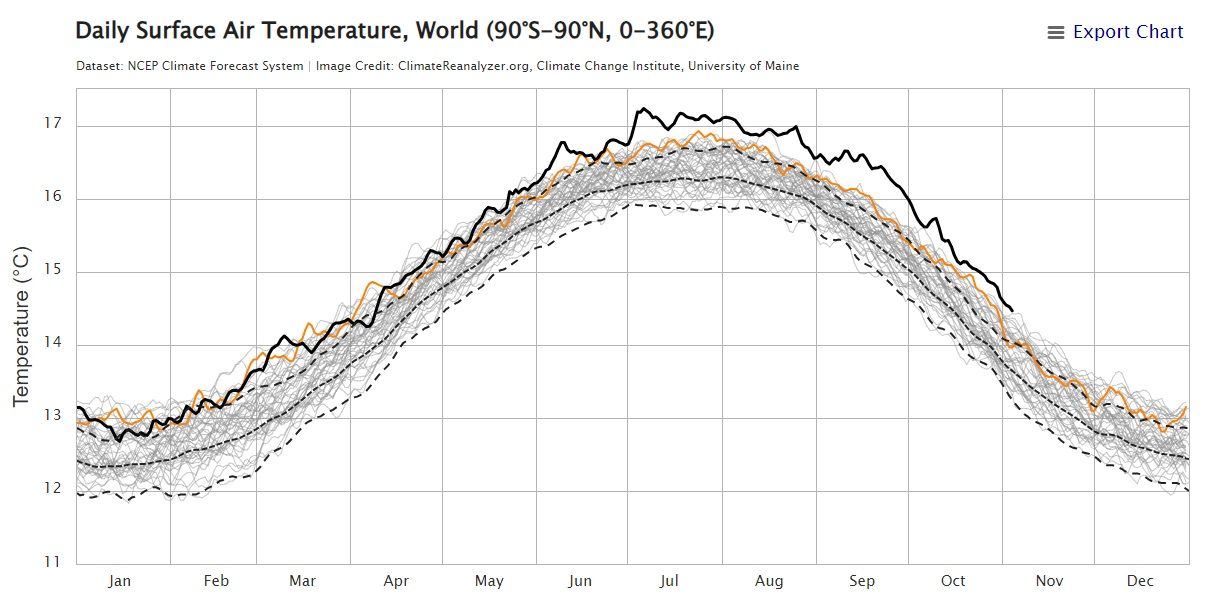
As a result, 2023 had some of the longest and most brutal heat waves in recorded history.
The year started with a spring-like January in Europe. Scientists called it the most extreme event ever seen in European climatology. Although they’ve been predicting that heat waves will happen earlier in the year, even they were surprised.
Parts of the United States also had spring-like temperatures early in the year. Many people talked about how great it was to have pleasant weather in February, but warm weather that early is terrible for biodiversity.
In April, a monster heat wave like none before hit Asia. Spain and Portugal also had record-high temperatures, and some people began to worry that the summer would be unusually hot. They were right.
The summer of 2023 ended up being the hottest summer ever with record heat waves all over the world. Almost every single day, new temperature records were set, often beating old records by huge margins.
In June, Puerto Rico recorded its highest-ever temperature at over 51°C. Soon after, Mexico and Texas had a heat wave that smashed all-time records, with parts of Texas surpassing 100°F almost every day. Over in Arizona, Phoenix went 31 days in a row with temperatures over 110°F.
In July, China recorded its highest ever temperature at 52.2°C. Days later, Europe also had some of its highest temperatures ever recorded. In fact, so many countries had record high temperatures that it might be easier to list the countries that didn’t have record temperatures.
South America also had a record-breaking heat wave, with temperatures reaching 38°C (100°F) in the middle of winter. Let me repeat that: South America reached 38°C—which would be a hot day in the summer—in the middle of winter. As one weather historian said, “This event is rewriting all climatic books.”
And incredibly, 2024 is expected to be even hotter. Climate scientists knew that climate change would eventually cause heat waves like these, but it’s happening decades earlier than expected. Clearly, we don’t have as much time as we thought.
Some people—especially those who work indoors all day—don’t take heat waves seriously. They figure that as long as they have air conditioning, they’ll be fine.
What they’re forgetting is that the majority of food production happens outdoors, and most crops can’t survive temperatures above 32°C for long. Just one severe heatwave can ruin an entire growing season, like the one that caused yield losses of up to 50% in Europe a few years ago.
They’re also forgetting that power lines are outdoors, too, and they begin to melt in temperatures above 45°C. As a result of these heat waves, people are cranking up their air conditioners and using more power than ever. But if the power lines melt and the grid goes down, there could be a mass casualty event.
To understand why, you need to know about something called wet bulb temperatures.
Wet Bulb Temperatures
A wet bulb temperature is the temperature of a thermometer when it’s wrapped in a wet cloth. When the water in the cloth evaporates, it carries heat away from the thermometer, making it cooler than a bare thermometer. This simulates the effect of sweat evaporating and cooling the human body.
But when the relative humidity is too high, sweat is unable to evaporate and the body can’t cool itself down. So if the wet bulb temperature is high enough, a healthy person could be sitting in the shade, under a fan, and drinking ice water, yet they would still die of heatstroke in a matter of hours.
In the past, scientists believed humans could endure wet bulb temperatures up to 35°C, but new research suggests that the human body isn’t as resilient in high temperatures as previously thought. They now believe that humans can only endure wet bulb temperatures up to 31°C, which is 87°F at 100% humidity.
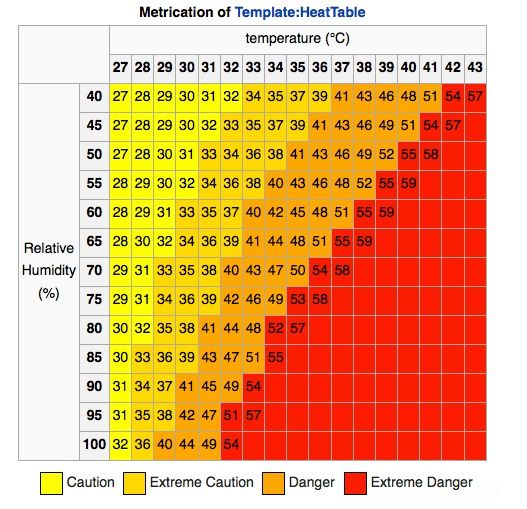
Fortunately, wet bulb temperatures high enough to kill humans are very rare. But in recent years, they’ve become more and more common.
Last summer, the power went out in parts of northern India. Hours later, the local hospitals were overwhelmed with patients suffering from heatstroke. In the end, nearly 170 people died. This is just a tiny preview of what’s to come.
According to the World Bank, India is on the verge of suffering heat waves that break the human survivability limit. If they’re unable to keep the power grid functioning, there could be heat waves that kill millions of people. Mass casualty events like that could happen anywhere the grid goes down.
According to research published in Nature Sustainability, at least 2 billion people will be left outside the “human climate niche” by 2100. Other research suggests it could be as many as 3 billion people by 2070. No doubt it will be even sooner as scientists keep warning that climate change is happening faster than expected.
Even if countries manage to keep their grids up and running, what about the livestock? In 2021, a heat dome in British Columbia killed at least 650,000 farm animals. In fact, thousands of cattle dying from extreme heat has become a yearly event in some places. This is yet another way in which climate change will lead to widespread food shortages.
Another major consequence of heat waves is wildfires, which seem to be getting worse exponentially.
Wildfires
In 2023, Canada had, by far, its worst wildfire season on record. In just one season, the fires burnt an amount of land equivalent to the size of North Dakota. Across the country, tens of thousands of people were forced to evacuate while firefighters attempted to get the 200+ fires under control.
The smoke from the fires was so severe that it caused the worst pollution event in U.S. history, with the skies turning red like the surface of Mars. To get an idea of just how bad Canada’s wildfire season was compared to previous years, take a look at the graph below.
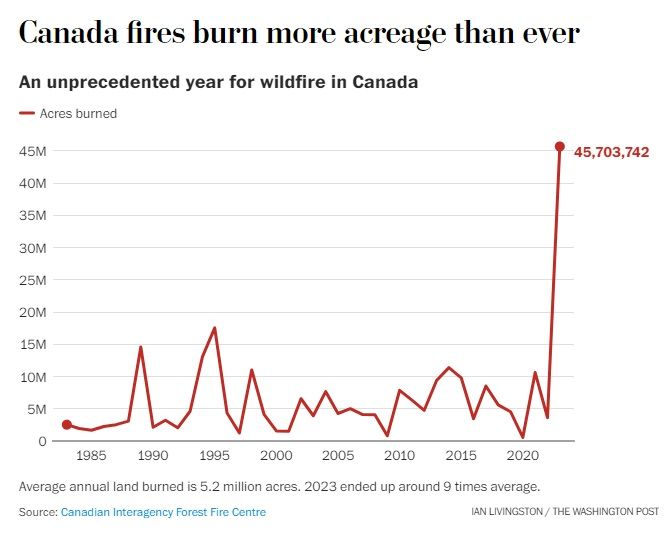
Canada isn’t the only place getting extreme wildfires. Hawaii had its deadliest wildfire in history, when hundreds of people died and thousands fled for their lives. And New Mexico got a year’s worth of wildfires in one month.
California’s wildfires also continue to get worse and worse. It’s so bad that many insurance companies are leaving the state rather than insuring countless homes at risk of burning down.
Over in the UK, firefighters faced the largest wildfire in the country’s history in 2023. Greece also suffered from a series of massive wildfires, forcing tens of thousands to leave their homes.
Even Siberia, one of the coldest places on Earth, seems to be burning more every year. And everyone remembers Australia’s “black summer” of 2019/2020, the worst wildfire disaster in modern history, when about 3 billion animals were displaced or killed.
But why is climate change making wildfires so much worse? It’s pretty simple: drought and heat. There have always been wildfires, but unusually dry and hot weather is killing trees and shrubbery, creating the perfect fuel. In California, for example, the drought killed 36 million trees in just one year.
Some people claim that wildfires were much worse back in the early 20th century. This is debatable as much of the data from back then is flawed. However, it’s true that by the 1960s, firefighters got much better at controlling wildfires and were usually able to stop them before they got too large.
Today, despite everything we know about wildfire prevention and management, the frequency and severity of wildfires has gotten much worse, and they’ll continue getting worse as the planet heats up. Countless homes and even entire towns will be lost forever. Meanwhile, air pollution will continue to cut people’s lives short.
Some climate deniers argue that all these wildfires aren’t because of climate change—they’re because of arsonists. Even if that were true, the fires wouldn’t spread so quickly and easily if not for extremely hot and dry weather.
Extreme Weather
Climate change isn’t just making floods, droughts, heat waves, and wildfires worse—it’s making all types of weather disasters worse. As the US Emergency Chief warned, severe weather is now the new normal.
One obvious example is hurricanes, which are definitely getting stronger. The oceans are now so warm that even weak hurricanes and tropical storms are rapidly intensifying. Recently, Hurricane Otis became the fastest-strengthening storm in history, going from a tropical storm to a category-5 hurricane in less than 24 hours and shocking meteorologists.
We’re now at the point where some hurricanes are worthy of a category 6 rating—that is, if the Saffir-Simpson scale went past 5. The National Hurricane Center has no plans to add a category 6 because they’re afraid people won’t take category 5 as seriously. But whatever they do, we’re going to see more category 6 equivalent hurricanes.
Climate change is also increasing the risk of back-to-back storms, which make it difficult for coastal communities to recover. China, for example, got slammed with multiple typhoons in 2023, resulting in the heaviest rainfall in 140 years and the displacement of over a million people.
We’re also seeing more frequent and powerful tornadoes. As temperatures rise, the type of storms that spawn tornadoes are becoming more common. In December of 2021, the National Weather Service confirmed the first quad-state tornado. The tornado travelled over 200 miles, which means it was likely the longest-lasting tornado in history.
We’re even seeing more blizzards. You would think that as the planet warms, there would be fewer snowstorms, but that’s not necessarily true.
Remember, the warmer the atmosphere gets, the more moisture the air can hold. And although the Arctic is warming fast, it will continue to have freezing temperatures for the foreseeable future. So when moist air makes its way North, it provides fuel for blizzards, like the so-called once-in-a-lifetime blizzard that killed 27 people in New York.
Some research has found that the number of blizzards has already doubled over the past two decades, and it’s going to get worse. So, if you thought you could escape climate change by moving North, get ready for some serious snowstorms.
You might be thinking, Okay, there’s a lot of extreme weather, but what does this have to do with the collapse of civilization?
That’s a fair question. After all, we’ve always had extreme weather, and governments usually spend money to clean up and repair the damage. The problem is that it’s getting harder and harder for governments to keep up.
Most of the world’s governments are running massive deficits, which means less money for storm recovery. This is a huge problem as billion-dollar disasters are becoming more common, even when adjusted for inflation. Lately, the United States gets hit with about 20 billion-dollar disasters every year. And in 2023, it hit a new record.
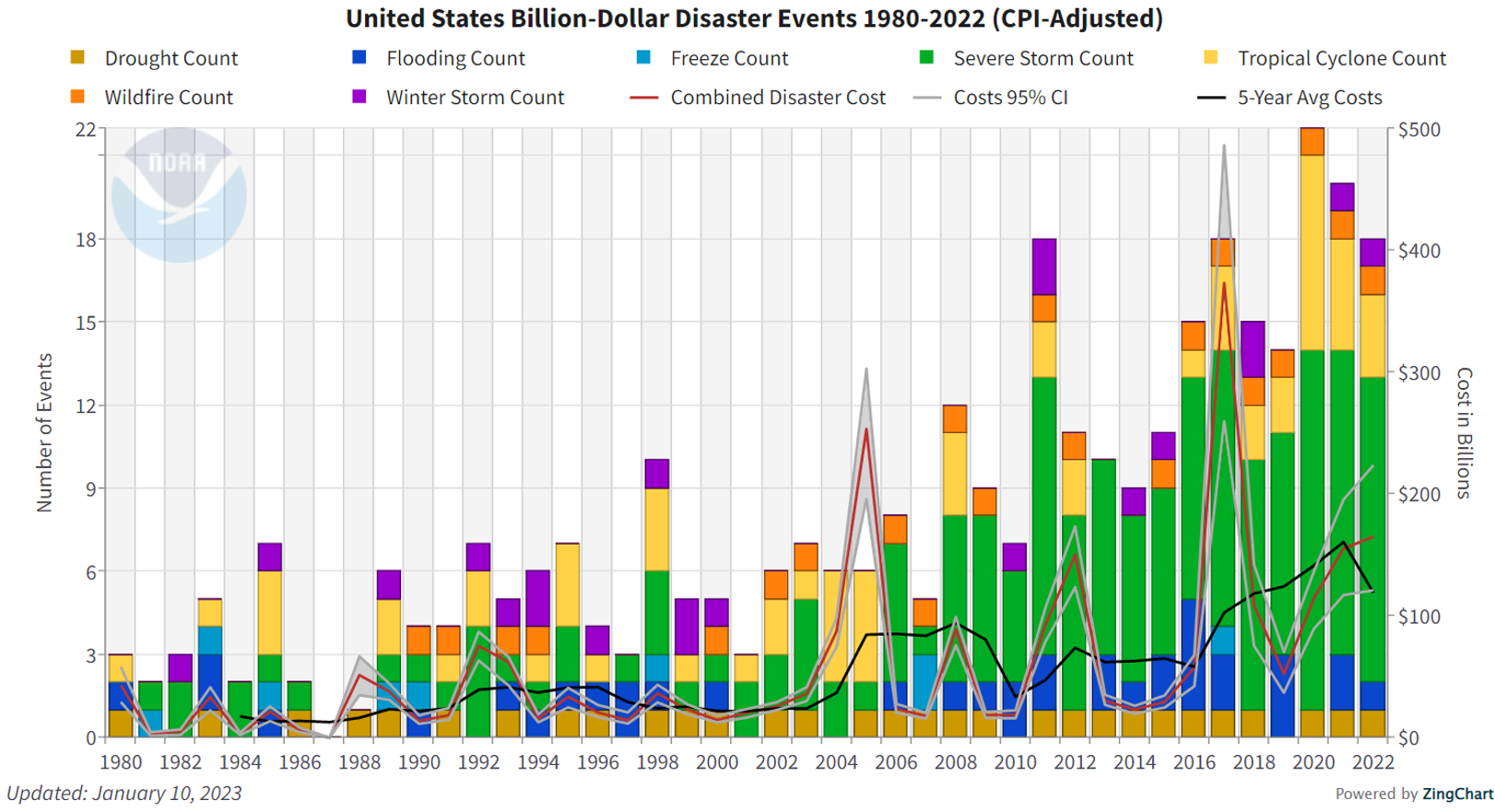
Already, many poorer states and nations don’t have the funds to fully recover from major disasters. And even if they do, they just get hit again a few years later. Pretty soon, even rich nations won’t be able to keep up with all the storm damage.
Infrastructure
Modern civilization can’t exist without adequate infrastructure. Clean water, reliable power, good roads, bridges, dams, trains, and airports—all of this is crucial for modern society. Unfortunately, we’re nearing a point when governments will no longer be able to maintain their country’s infrastructure.
In the United States, the American Society of Civil Engineers (ASCE) gave the country’s infrastructure a grade of C-, which means most of it is in fair or poor condition. The Biden administration signed a $1 trillion infrastructure bill into law, but it’s not nearly enough.
The ASCE warned that the U.S. infrastructure gap is about $2.59 trillion. If it doesn’t close this gap, then by 2039, the lack of adequate infrastructure will cost the U.S. economy $10 trillion in GDP.
But what exactly does that mean? It means more roads will crumble, more water mains will break, and more bridges will collapse. One study found that as many as 1 in 4 steel bridges in the U.S. could collapse by 2040. It’s hard to maintain supply chains without bridges.
An even bigger problem is the power grid. Without reliable energy infrastructure, grids are going to fail on a regular basis as they’re hit with one climate disaster after another, like what happened to the Texas power grid in 2021. As many energy experts have warned, the U.S. electric grid wasn't designed to withstand the impacts of climate change.
Water infrastructure is also crucial, but even in first-world countries like the United States, clean water is becoming a luxury. We’ve already seen water systems fail in places like Flint, Michigan and Jackson, Mississippi. Consider these as previews of what’s coming to your town.
Without functioning water and sewer systems, all sorts of problems occur such as sewage backing up into homes, contaminated ground water, and the spread of waterborne diseases such as cholera.
Disease
Climate change is already fueling a global surge in cases of cholera, which can cause severe dehydration and death in a matter of hours.
There are several reasons for the surge, but the main reason is drought, which has led to a lack of clean water. Many people don’t appreciate how much they rely on clean water to stay healthy. When there’s not enough water for personal hygiene, diseases like cholera run rampant.
You might think that as long as we create and distribute plenty of antibiotics, we can minimize deaths from bacterial diseases. Unfortunately, our overuse of antibiotics over the past century is leading to rise in antibiotic-resistant superbugs.
If you’re like most people, you probably have no idea the crucial role antibiotics have played in your life. Antibiotics have saved the lives of hundreds of millions of people who would have died from infections that are now easily treatable. I, myself, might have died from a nasty case of infectious colitis if not for antibiotics.
But now, about 1 million people die every year due to antibiotic-resistant infections, and it’s going to keep getting worse. In fact, the World Health Organization believes that antibiotic resistance will be one of the leading causes of death by 2050.
As if that weren’t bad enough, climate change could potentially throw us a curve ball in the form of ancient diseases. As the planet gets warmer, it’s causing permafrost (ground that is frozen year round) to rapidly thaw. This is a huge problem because we don’t know what sorts of bacteria and viruses could be frozen inside the permafrost.
Several years ago, there was an outbreak of anthrax in Russia that killed one child and infected 2000 reindeer. Scientists believe the outbreak came after a heat wave melted permafrost along with the frozen carcass of a deer that was infected with anthrax decades ago. There’s no telling what other diseases could resurface as the planet warms.
Melting glaciers are also a threat. Scientists have found that glaciers are releasing a staggering amount of unknown bacteria, some of which could be deadly to humans. And in Tibet, scientists discovered never-before-seen viruses inside a glacier, which is why some experts believe the next pandemic could come from melting glaciers.
Speaking of pandemics, there’s going to be another one in the near future (not that the last one ever ended). As the planet warms and deforestation continues, more wild animals will be forced to relocate, increasing the risk of cross-species viral transmission. The only question is where exactly the next pandemic will come from.
Currently, the most likely candidate is H5N1, commonly known as “bird flu.” In case you haven’t heard, bird flu is absolutely decimating bird populations around the world. It’s so bad that roughly half of all bird species are in decline. Poultry farmers have culled over 40 million chickens to try to stop the spread, but experts believe it’s already endemic.
Normally, H5N1 only infects birds, but recently it has started spreading to mammals. Oftentimes, this happens when a wild animal such as a fox comes into contact with an infected bird. The virus can spread to mammals, but not among mammals. However, it appears that has changed.
In 2022, there was a bird flu outbreak at a mink farm, which is incredibly concerning. It looks as though bird flu has gained at least one mutation that favors mammal-to-mammal transmission. If it keeps mutating, it’s only a matter of time before it spills over into humans.
According to the WHO, bird flu has a fatality rate of 56% in humans. The fatality rate would probably be much lower if it turned into a human pandemic. However, considering that the fatality rate of COVID-19 is less than 1% in most countries and it still caused massive disruptions, one can only imagine what a pandemic with a much higher fatality rate would do to the world.
There are countless ways in which climate change will exacerbate diseases in the coming years. And unfortunately, most governments are not doing what’s necessary to prepare.
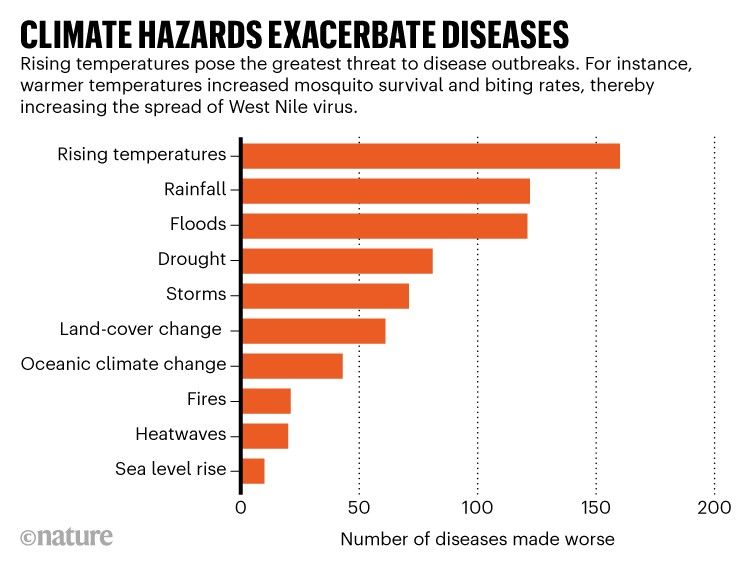
Sea Level Rise
There are a lot of misconceptions about sea level rise. For some reason, the mainstream media has focused on this particular symptom of climate change while ignoring other problems such as crop failures and new diseases.
As a result, many people have the impression that sea levels were supposed to be higher by now. Oftentimes, climate deniers will say things like, “New Orleans was supposed to be underwater 10 years ago.”
That’s not true at all. No credible climate scientist has said that any major cities would be underwater by now. Most of them predicted less than a foot of sea level rise by 2020, and they were right. But more recently, sea levels have been rising faster than expected, and we’re going to start seeing major consequences in the coming decades.
Over the next 30 years, sea levels are going to rise as much as they did in the entire twentieth century. According to the National Oceanic and Atmospheric Administration, the United States will see 10-12 inches of sea level rise by 2050.
That might not sound like much, but for every 1 foot of sea level rise, about 100 feet of shoreline is swallowed up during high tide, on average. Now think about the coasts of the United States and how many roads and properties are within 100 feet of the shoreline. We’re talking about at least $1 trillion in property.
The insurance industry is well aware of this problem, which is why some insurance companies have been pulling out of states such as Florida. Thanks to sea level rise, many properties are becoming uninsurable. As one watchdog group explained, "The growing insurance crisis illustrates the vital importance of seeing climate change as a risk to the entire financial system.”
Most people think of sea level rise as a problem for the next generation, but it’s already affecting the economy right now, and it’s going to get worse sooner than expected. As it turns out, scientists have been underestimating the impacts of sea level rise due to faulty radar data. Since radar is unable to fully penetrate vegetation, it overestimates surface elevation.
Several major cities such as Amsterdam, New Orleans, Venice, and Bangkok could be underwater during high tide by 2030. In fact, many coastal cities are already being inundated, and not just because of sea level rise, but because of land subsidence due to groundwater extraction, a problem that will affect 1.6 billion people by 2040.
As a result, hundreds of millions of people will be forced to relocate. Where will they go?
Climate Migrants
The climate migrant crisis is one of the most overlooked consequences of climate change—and one of the worst. This single issue is going to cause widespread chaos in the coming years. Michael L. Fox does a fantastic job of explaining the problem here, but I’ll give you the short version.
The International Organization for Migration estimates that there will be up to 1 billion climate migrants by 2050. The Institute for Economics and Peace (IEP) is even more pessimistic, estimating 1.2 billion climate migrants by 2050. No one has disputed these figures.
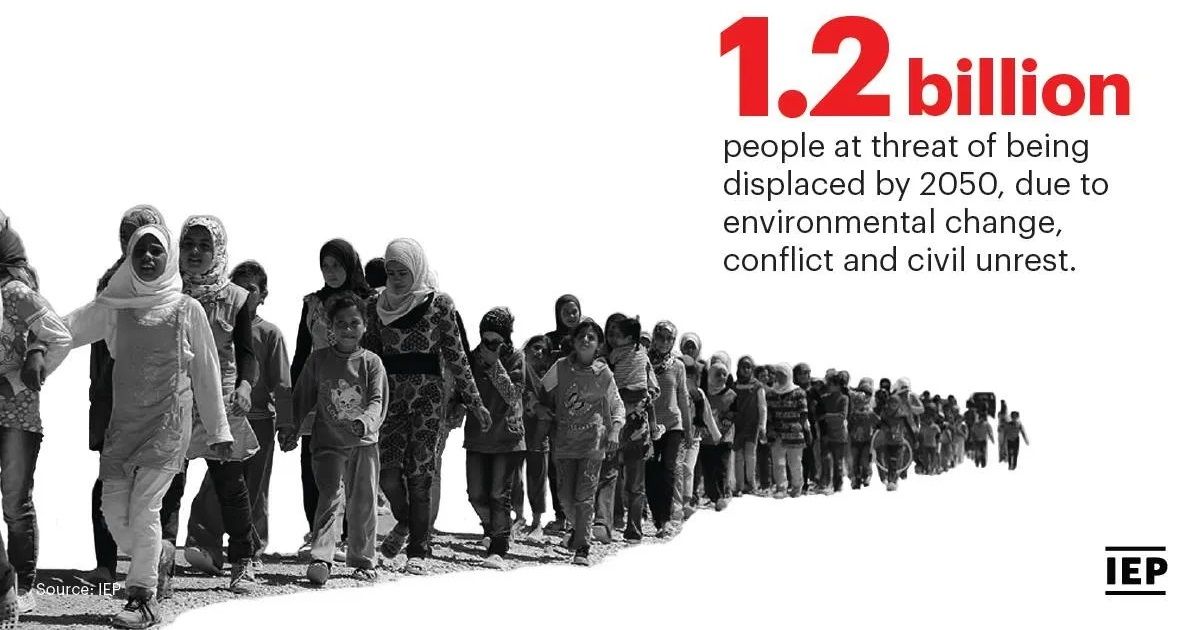
The IEP arrived at this number by looking at data from the 2020 Ecological Threat Register and the Economist Intelligence Unit. They assessed 157 states and territories for ecological threats with respect to food, water, natural disasters, and population growth. They also looked at the resilience of each country and how they would handle crises such as water scarcity or lower crop yields.
Their analysis showed that most of these countries simply don’t have the resources and institutions to cope with the coming climate disasters. Crop failures, water scarcity, energy shortages, and intolerable heat will make many countries unlivable. For example, Iran—a country of 88 million people—will be mostly uninhabitable by 2050.
1.2 billion migrants sounds like a lot, but the real number is probably much higher as the report ignores the United States, Europe, India, and China. This is ludicrous. We already know that millions of people are going to flee the Western and Southern United States as water scarcity, wildfires, heat waves, and hurricanes get worse.
In Europe, millions are going to leave Portugal, Spain, and Italy due to droughts, floods, and crop failures. And in Asia, tens of millions are going to head toward Europe or Russia to escape climate disasters.
It’s tempting to think of 2050 as far away, giving us plenty of time to come up with solutions, but it’s not like all the migrants will show up on January 1st, 2050. Climate migration has already begun, and it will get exponentially worse over time.
I should also point out that these reports came out several years ago, before the climate crisis began to accelerate. Although climate deniers accuse scientists of being alarmist, the reality is that climate change is happening faster than scientists expected. This year, we’ve seen off-the-chart records.
Considering that the IEP seems to be vastly underestimating the number of climate migrants, and considering that climate change is happening faster than they thought it would, I think it’s reasonable to assume that we’ll see a billion migrants as early as 2040.
But what exactly does that mean? 1 billion is a huge number, so it’s hard to wrap your head around the idea of that many people migrating. For a point of reference, let’s look at the European refugee crisis. As explained in this paper, “The European refugee crisis began when the flow of migrants increased dramatically from 153,000 in 2008 to more than 1 million in 2015.”
Think about that. Just over 1 million migrants per year caused a “refugee crisis.” As a result, there was a major rightward shift in European politics. Countries started building massive walls to keep out the refugees, and the people of the UK became so xenophobic that they imposed Brexit on themselves, wrecking their own economy.
If a million migrants per year can cause all this, how will Europeans react when there are tens of millions pouring in every year? Will Europe be able to feed and house that many people? And if not, what kind of chaos and conflict will it cause?
In America, we’re already seeing a sharp increase in racism and xenophobia due to the rising number of migrants. Last year, about 2.4 million migrants were apprehended at the US-Mexico border. How will Americans react when there are 20 or 30 million migrants attempting to enter the country every year?
We already know the answer. America will be in an economic depression by then. People will be frightened and angry, and they’ll be looking for someone to blame. In all likelihood, they will elect a strongman who will “do what’s necessary.” Something like the holocaust seems plausible.
If you think that’s alarmist, you’re ignoring history. Societies have become absolutely brutal over smaller problems. We simply cannot have a stable, functional, global civilization when every year, a huge chunk of the world population is forced to abandon their homes.
Supply Chains
Supply chains are complicated. Very complicated. So complicated that no one fully understands them. And yet, we rely on supply chains to bring us food and essential items every single day. The map below shows the journey of just a few day-to-day items.
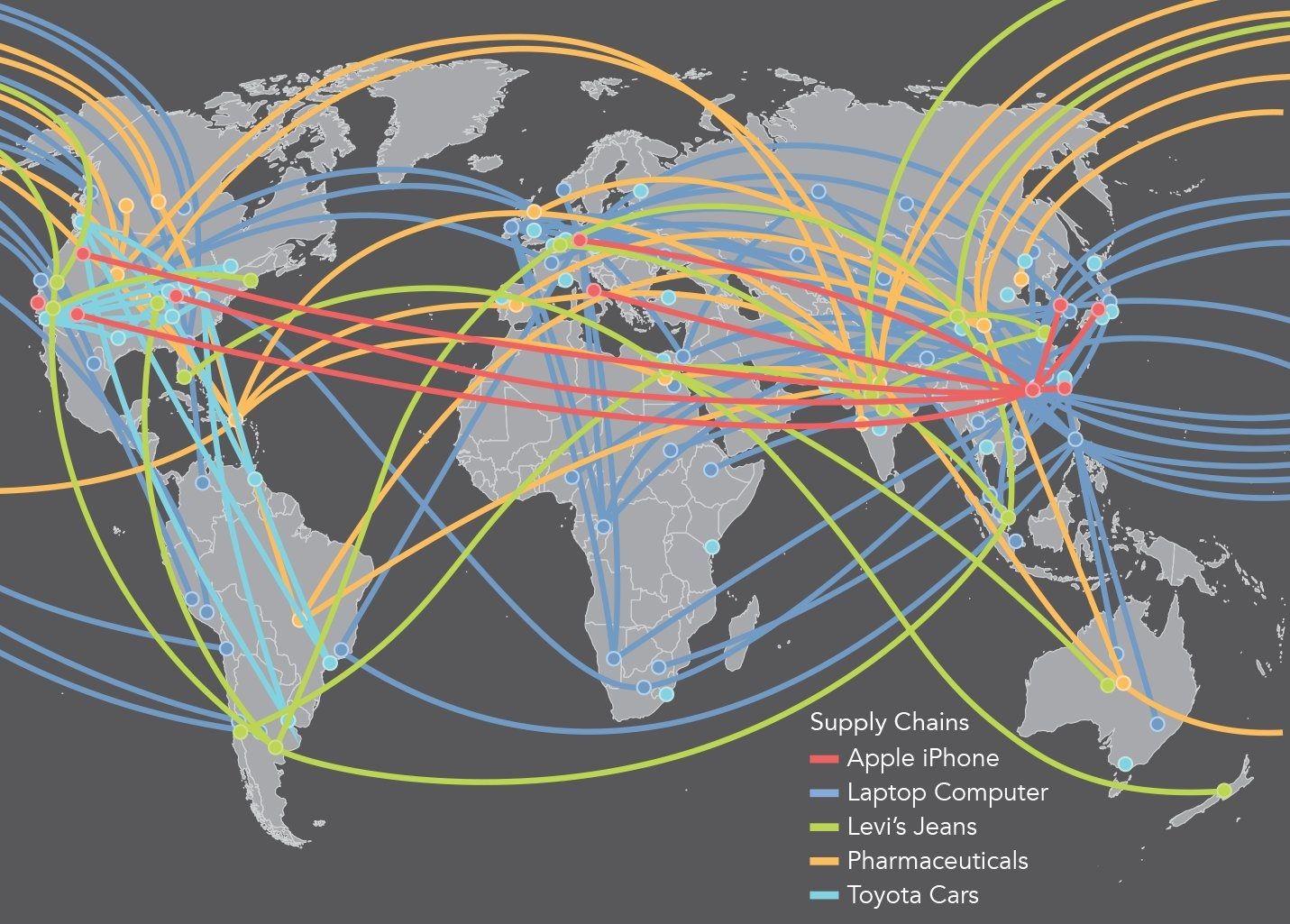
Take Apple iPhones, for example. To create their products, Apple works with suppliers from 43 countries across 6 continents. If one of those countries were to collapse into chaos, it would have an immediate impact on Apple, which would have to find suppliers elsewhere.
As more and more countries fall, it will get harder for Apple to get the raw materials and components they need. The same is true for all the other everyday items we take for granted.
There’s a tendency among people in first-world world countries to assume that if civilization collapses, it will happen in third-world countries first and not happen to their country until years later, if ever. By assuming this, they’re underestimating how much the collapse of the third world will impact the first world.
Remember all the supply chain problems we had during the pandemic? When factories in the China shut down due to covid-19 outbreaks, there were lots of shortages along with a spike in inflation. Now imagine that times 100.
First-world countries rely on cheap labor and resources from the global South to supply them with affordable products. When those countries collapse and supply chains break, the wealthy nations will be helpless.
Crop Failures
According to a report by the FAO and research published in Nature Food, if the global population grows to somewhere between 9 and 10 billion by 2050, then we’ll need to increase food production by around 50%.
That is not going to happen.
The Global Commission on Adaptation has warned that without immediate and drastic cuts in emissions, global agricultural yields could drop as much as 30% by 2050. Farms are already being stretched to a breaking point, and it’s going to get much worse over the next few years.
There’s an assumption by many that climate change hasn’t affected crop yields yet, but that’s not true. In fact, climate change has already cut global farming productivity 21% since the 1960s, and this is just the beginning.
Global crop problems are already increasing food prices. Last year, extreme weather cost American farmers $22 billion and caused the price of vegetables to rise up to 40% across much of the United States. Winter wheat harvests fell by a quarter, and the year before that, the US had its smallest wheat crop in 20 years.
Things are just as bleak in Australia, where farmland is being abandoned due to a series of droughts. Bangladesh is also abandoning its farms, but for different reasons. As the oceans rise, saltwater intrusion is destroying farmland. As I already mentioned in the section on floods, rice output in Asian countries is at risk.
All this is just a small sample of what’s happening at a mere 1.2°C of warming. According to researchers from CUHK and the University of Exeter, yields of corn, wheat, and rice could fall 22% by 2050. Meanwhile, the global population keeps rising.
When one breadbasket fails, the other breadbaskets usually make up the difference. For example, right now China is importing wheat from France and Australia to make up for its unusually small wheat harvest. But what happens when multiple breadbaskets fail at the same time?
This might seem unlikely, but scientists say they’ve underestimated the risk of simultaneous crop failures. The latest research suggests that the meandering jet stream could cause lower crop yields in North America, Eastern Europe, and East Asia all in the same year, or in back-to-back years.
Politicians can deny that we’re on the verge of a global famine all they want, but the insurance industry knows better. According to Lloyd’s, the oldest insurance marketplace in the world, climate-induced food and water shortages could soon cost the world economy $1 trillion per year.
As with every other facet of climate change, the effect on agriculture is happening faster than expected. Crop harvests are already insufficient to meet the UN’s food security goal, and it’s all downhill from here.
Can’t We Just Move The Farms North?
There’s a popular idea that as the planet warms up and southern lands become too hot for agriculture, lands that were previously too cold—such as Siberia and North Canada—will become ideal for growing large amounts of food. But is this actually possible?
The short answer is no. This article by Ben Shread-Hewitt explains why in detail, but I’ll give you the gist of it. The main problem with the idea of moving farms north is that it assumes global warming will happen evenly, with predictable effects.
That’s not how global warming works. The Arctic is warming four times faster than the rest of the planet, and it’s going to make weather more erratic than ever, as explained above in the section about the jet stream.
Even if the planet did warm evenly, there are other questions to consider. For example, how quickly could we convert the acreage into farmland? It takes time to cut down tress, build silos, and construct the infrastructure necessary for large farms.
And who will work on these farms? Many of Russia’s able-bodied men are busy fighting a war that is expected to last for years. Already, some of their farms have been abandoned because there aren’t enough people to work on them.
Here’s another question: What about the wildfires? Much of this supposed future farmland sits in Siberia, which has been struggling with wildfires for years. Canada is also dealing with severe wildfires. If one of them burns down a farm, it won’t just destroy the crops—it will destroy all the farm buildings as well.
Yet another question has to do with permafrost. What happens when it thaws and massive craters open up beneath the farms? The land will be abandoned. Research shows that hundreds of craters are forming all the time. I wouldn’t want to work on a farm that could collapse into the Earth at any moment.
Unfortunately, moving the farms north is not a realistic option.
Climate Change is Accelerating
James Hanson once said, “Imagine a giant asteroid on a direct collision course with Earth. That is the equivalent of what we face now.” Some people call this hyperbole since climate change has been so gradual over the past several decades, but when you understand that climate change is accelerating, it makes perfect sense.
CO2 remains in the atmosphere for hundreds of years, and the more CO2 accumulates, the faster heat accumulates. That’s why over the past 20 years, the atmosphere has warmed 4 times faster than in the period from 1961 to 2000. Meanwhile, global greenhouse gas emissions are at an all-time high.
Consider this: It took 40 years to increase global temperatures by 0.8°C (from 0.4°C of warming in the 1980s to 1.2°C of warming today), and we’re going to raise it another 0.8°C in just 20 years, bringing us to the dreaded 2°C threshold by the early 2040s.
You think the weather is bad now? Just wait.
The signs that climate change is accelerating are all around us. In the spring of 2023, scientists began to point out that sea surface temperatures were at record highs. This was shocking considering that El Niño hadn’t actually begun yet. Even more shocking was the fact that sea surface temperatures stayed at record highs month after month.
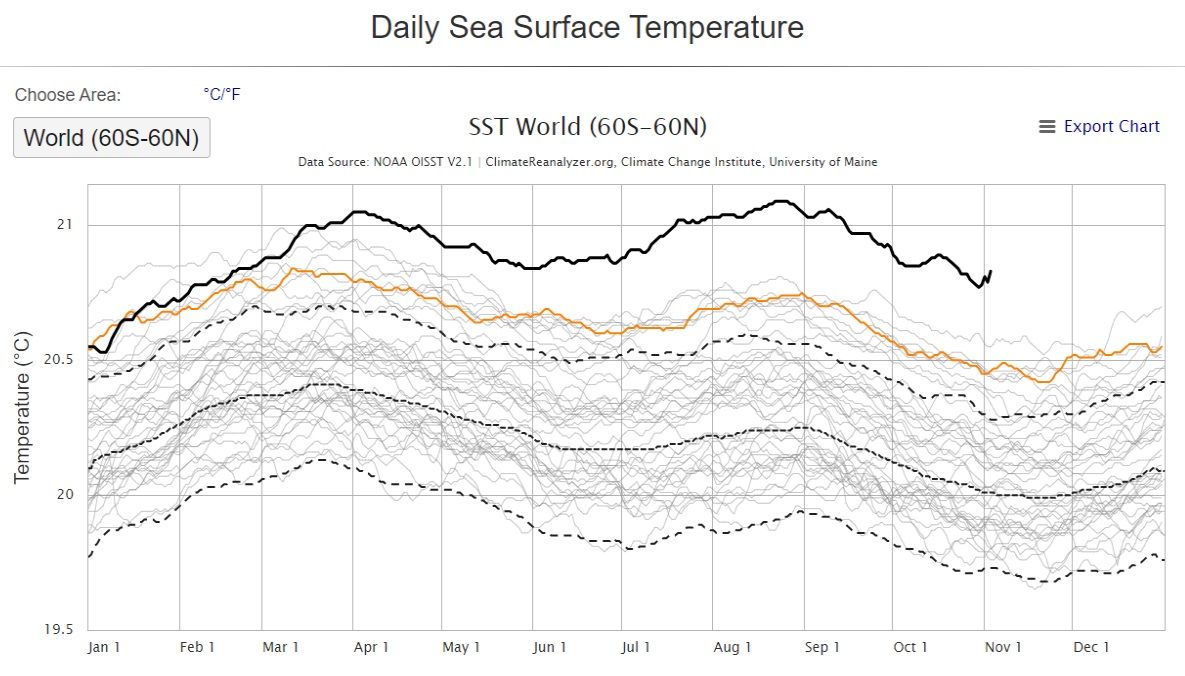
On July 3rd, the world had its hottest day in recorded history, and the next day was even hotter. July ended up being the hottest month ever recorded, and likely the hottest month in the past 100,000 years.
August was the hottest August in history. September was the hottest September in history. October was the hottest October in history.
Are you sensing a pattern?
Although El Niño is part of the reason temperatures rose so quickly this year, they’ve still risen higher than expected. As professor Stefan Rahmstorf said, “We do understand the global warming caused by fossil fuels - for four decades it’s been going as predicted. But we don’t understand the surprise upward leap that is happening now. And that worries me.”
Tipping Points
Many people say that if we drastically cut emissions and start sucking carbon dioxide out of the atmosphere (which isn’t even feasible), we can still prevent runaway warming. That might be true if it weren’t for tipping points.
A tipping point is a threshold that, once crossed, leads to sudden and often irreversible changes. There are many tipping points in the climate system, but one we should all be worried about right now is the thawing of the permafrost.
The northern permafrost, which stretches around the Arctic circle—including places like Alaska, Northern Canada, and Siberia—contains about 1500 gigatons of CO2. To put that in perspective, the entire world emits about 37 gigatons of CO2 every year.
As the permafrost thaws, it releases CO2 and methane into the atmosphere, which leads to more warming, which causes the permafrost to thaw even more in a positive feedback loop.
Another important tipping point is the Arctic sea ice. Currently, the sea ice reflects sunlight away from the Earth. This is called the albedo effect. But when the sea ice melts in the summertime, less solar radiation is reflected and more of it is absorbed by the ocean.
The Arctic reaches its minimum sea ice extent in September. Once we reach a point where there is no sea ice during that month (called a blue ocean event), the ocean will start absorbing far more solar radiation than it used to, and it will warm up even faster. The next year, there will be no sea ice in the summer for a longer stretch of time, which will cause even more warming, and so forth.
According to this study, the amount of solar energy that would be added due to the complete disappearance of Arctic sea ice during the sunlit part of the year “would hasten global warming by an estimated 25 years.”
It’s hard to overstate how disastrous that would be. If global warming were to speed up that quickly, we would cross many other crucial tipping points. So, can we avoid this scenario?
No. The latest research suggests that the Arctic will be ice-free in September in about 10 years, even with sharp emissions cuts. Once that happens, there’s no turning back.
In a way, this scenario is already playing out around Antarctica. This year, scientists were shocked by the sudden drop in sea ice extent around the continent. As oceanographer Edward Doddridge said, “To say unprecedented isn’t strong enough.”
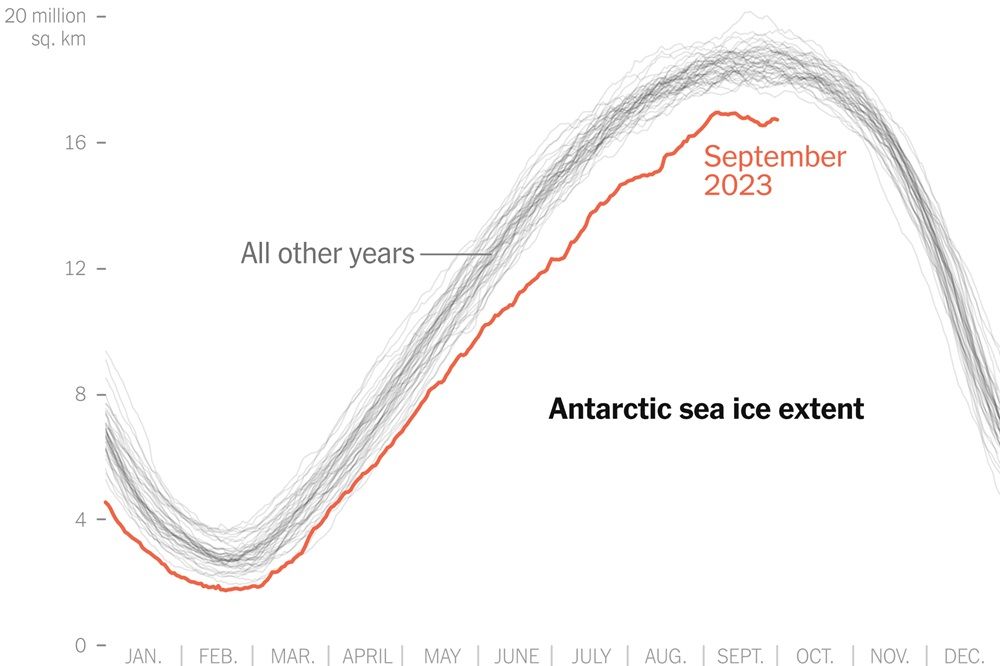
2023’s Antarctic sea ice minimum was 20% lower than the average over the last 4 decades. By August, the amount of missing sea ice was equivalent to an area about 10 times the size of the UK, and it is now absorbing sunlight instead of reflecting it. This will cause the ocean to warm even faster.
Considering that this year already had shockingly high ocean temperatures, we can only imagine what next year will bring.
Climate scientists have identified over a dozen tipping points we must avoid, and we’re already on the brink of crossing five of them, including the ones mentioned above along with the Greenland ice sheet collapse, the West Antarctic ice sheet collapse, and the tropical coral reef die-off.
If global warming crosses the 1.5°C threshold, we will trigger multiple tipping points. This is why climate scientists say that 1.5°C of warming and below is the “safe zone” for civilization.
So can we still avoid warming the planet by 1.5°C? A scientist would say that is “extremely unlikely,” but I’m going to give it to you straight: No, there is absolutely no way we can avoid 1.5°C of warming.
This year, we already had a record number of days above 1.5°C. We still haven’t averaged 1.5°C of warming for an entire year, but it’s only a matter of time. Organizations such as the IPCC don’t want to admit this, presumably because they don’t want people to lose hope.
But as James Hansen explains in this paper, 2023 had monthly temperature anomalies of up to 1.7°C above the 1880-1920 mean. Temperatures usually decline about 0.2-0.3°C from an El Niño peak, so if El Niño peaks as high as expected, “The 1.5°C global warming level will have been reached, for all practical purposes.”
Is There Any Hope?
Some people simply refuse to accept that it’s too late to prevent catastrophic climate change. There are many reasons for this. For one thing, it’s terrifying. No one wants to believe that civilization is doomed, especially people who are young or have children.
That’s why many people keep insisting that if we drastically cut emissions right now, we can still prevent the worst of climate change. Here’s why that’s unrealistic.
First of all all, our civilization is completely dependent on fossil fuels. If we stopped using them all of a sudden, people would riot and civilization would collapse, anyway. We need fossil fuels for supply chains, for growing food, and for about 90% of industrially manufactured products.
Many people like to fantasize about a green energy grid, but even if such a thing were possible, we would have to use fossil fuels to build it because, as Kevin Anderson explains, “Those are the energy sources we currently have.”
Right now, renewables account for about 12% of energy usage, so we have a long way to go. The amount of fossil fuel burning that would be required to rebuild our entire energy infrastructure would add so much CO2 to the atmosphere that we would cross multiple tipping points and still end up destroying the biosphere.
For a moment, let’s pretend I’m wrong. Let’s imagine that we achieve world peace and governments use all the money wasted on the military to construct solar panels, wind turbines, electric vehicles, and other low-carbon technologies. And let’s pretend they can do it all without adding more greenhouse gases to the atmosphere.
If that happened, then for the next few years, global temperatures would rise even faster. Seriously. And it’s because of something called global dimming, the best kept secret in climate science.
When fossil fuels are burned, they pollute the atmosphere with aerosols and sulfur dioxide, and those things reflect sunlight away from the planet. If it weren’t for global dimming, climate change would be 40-55% worse than it already is.
In fact, the drop in air pollution over the past couple of decades has already worsened global warming. If we were to stop burning fossil fuels completely, the subsequent jump in global temperatures would trigger multiple tipping points and cause runaway warming.
Humanity has painted itself into a corner.
Uncharted Territory
Over the past 100 years, the planet has warmed about 10 times faster than it usually does at the end of an ice age. Normally, it takes thousands of years for the planet to warm by a few degrees, but we’re going to do it in just one century.
As Will Steffen once said, “We’re talking about a shift as big as between an ice age when mastodons and wooly mammoths were around and humans barely survived. We’re talking about the same difference, but not in 5,000 years, in one century… In my view it is impossible to survive that sort of change. That’s beyond human physiology… In fact large mammals as a whole will not do very good… That’s a collapse scenario… Because physiologically, we can’t survive that.”
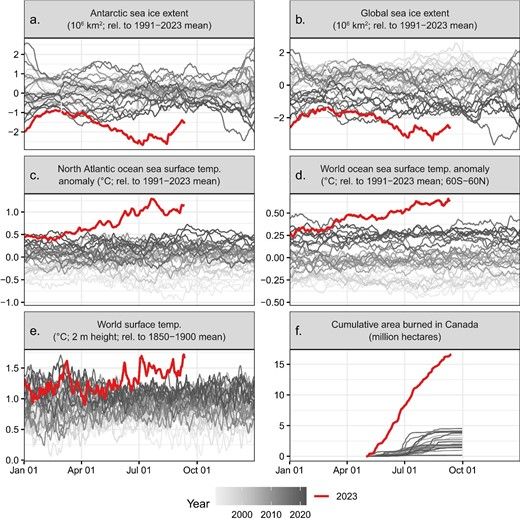
In the fall of 2023, a team of scientists published The 2023 State of the Climate Report, and what they wrote is incredibly ominous. Here are some quotes:
“We are entering an unfamiliar domain regarding our climate crisis, a situation no one has ever witnessed firsthand in the history of humanity.”
“For several decades, scientists have consistently warned of a future marked by extreme climatic conditions because of escalating global temperatures caused by ongoing human activities that release harmful greenhouse gasses into the atmosphere. Unfortunately, time is up.”
Here is the most disturbing quote: "The effects of global warming are progressively more severe, and possibilities such as a worldwide societal breakdown are feasible and dangerously underexplored.”
Many other scientists have echoed this sentiment. Professor Nick Cowern said, “If we don't stop burning fossil fuels by 2030-35 at ABSOLUTE LATEST we seriously risk runaway warming and civilisation's end.”
And Julia K. Steinberger, a lead author for the IPCC, once said, “Climate change impacts WILL FOR SURE cause billions to die of starvation on our current trajectory towards ~3C.”
Before you tell yourself, “Well, that won’t happen until late in the century,” consider this: Land surface temperatures are rising about 50% faster than the global average. The current average land temperature is about 1.8°C above pre-industrial times. When we reach 2°C of warming in the early 2040s, the land will reach 3°C.
That means the average temperature of the land on Earth is going to rise another 1.2°C in just two decades. This is an apocalyptic rate of change that we are not prepared for. All the problems described in this article will be turbocharged over the next two decades and beyond.
But instead of preparing for the coming disasters, governments are preparing for World War III.
Summary
As long as this article is, it could have been much longer. I didn’t even mention methane, the most potent of all greenhouse gases, which is rising as fast as it usually does when an ice age ends. And I didn’t mention the coming collapse of the AMOC, which will change the global climate practically overnight. But I think I’ve made my point.
To sum up, human civilization came to be during an unusually stable epoch known as the Holocene, which brought predictable weather patterns that made large-scale agriculture possible. Now that the Holocene is over, growing food is going to become increasingly difficult.
The polar jet stream is falling apart, causing wild fluctuations in weather patterns. Some parts of the world are experiencing horrific floods on a regular basis. Other parts are experiencing the worst megadroughts in millennia. This has forced farmers to rely on aquifers, which will dry up over the next few decades.
Temperatures are skyrocketing all around the globe, and some places will soon be so warm that they cross the human survivability limit, making any power outage a potential death sentence. The heat is also fueling some of the worst wildfires ever, and this is just the beginning.
The extreme weather we’re seeing is already worse than the worst-case scenarios, and the cost to the global economy will be in the trillions. As economies stagnate and sea levels rise, governments will struggle to repair or even maintain infrastructure, which will cause even more economic problems.
As food and water shortages worsen, diseases like cholera will become widespread, and a major global pandemic will become more and more likely. Even the world’s best healthcare systems will be completely overwhelmed.
All of this will lead to the worst migrant crisis in history, with over 1 billion climate migrants by 2050. The tensions will cause all sorts of internal conflicts, and the race for the last remaining resources will cause more wars, which will threaten our fragile supply chains.
Eventually, food production will fall permanently short of demand, and we’ll see a general breakdown of law and order. During this time, the chance of a nuclear war will skyrocket as desperate world leaders feel they have nothing to lose.
Although many people believe we can still avoid this dark future, the truth is that it’s already too late. We are going to reach 2°C of global warming no matter what we do, and by then we’ll have triggered several irreversible tipping points that raise temperatures so high in the long run that humans might even go extinct.
As terrible as all this sounds, it’s actually much worse. Even if there were no such thing as climate change, we would still be headed for collapse in the next few decades. Why? Because civilization is inherently unsustainable.
As William Ophuls said in his book, Apologies to the Grandchildren, “Civilization is, by its very nature, a long-running Ponzi scheme. It lives by robbing nature and borrowing from the future, exploiting its hinterland until there is nothing left to exploit, after which it implodes.”
We are now very close to the end of global industrial civilization. How sudden and dramatic the collapse will be is up for debate. Sam Hall wrote a brilliant essay in which he argues that the global population will likely be under 2 billion by 2050. I don’t know if the population will drop that quickly, but based on everything I’ve learned, it's very possible.
One thing’s for sure: The vast majority of people alive today will have their lives cut short due to societal collapse.
So what now? In order to minimize your pain in the coming years, I believe it’s wise to gather some emergency supplies, learn some basic skills, and make friends in your local community.
Beyond that, all you can do is live your life to the fullest and enjoy each and every day as much as possible. Be careful how much time you spend doomscrolling, and make time for things that matter to you. Be grateful for every moment of joy, no matter how small.
If this article made you anxious or depressed, this page has a list of resources that can help. Thank you for taking the time to read this mammoth of an article, and please share it with anyone you’d like to warn.
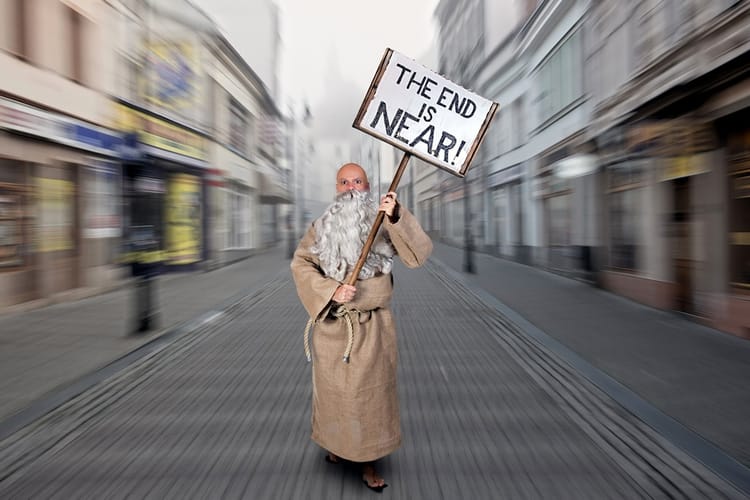

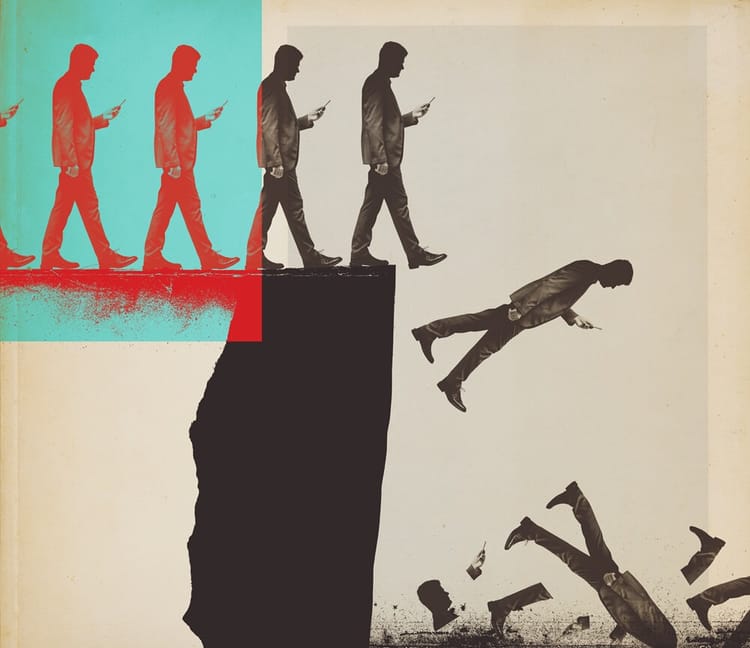


Member discussion